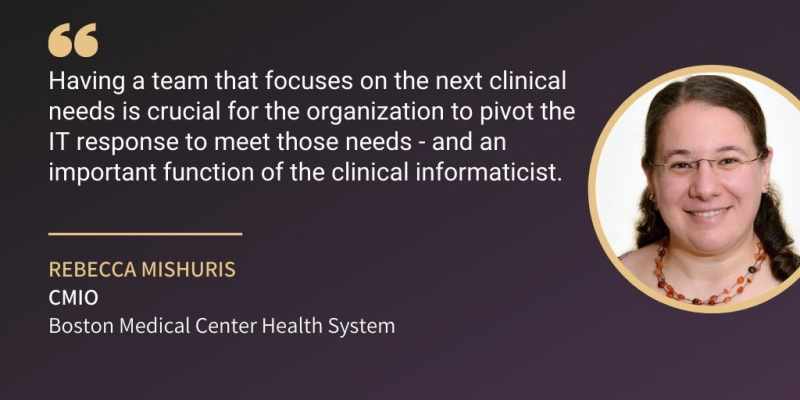Lessons from a pandemic response: the role of clinician in IT
By Rebecca G. Mishuris, MD, MS, MPH, CMIO, Boston Medical Center Health System
I have written before about the role of clinician in healthcare IT – the crucial part that the clinician informaticist plays in translating the end-user (e.g., provider, nursing, patients) needs to IT build, and vice versa. I have even stood on soapboxes to broadcast this message. However, the COVID-19 pandemic laid bare the importance of the clinician in another area: prioritizing IT projects, particularly when it comes to introducing new technologies.
There are two key approaches when it comes to the push-pull of technology – business and operational needs driving IT or IT pulling the organization to find new needs. Where your organization lies on this continuum depends on many factors, but in healthcare, clinical and administrative operations almost always drive the IT agenda rather than the other way around. Although this sometimes means that new technology is introduced more slowly than in other types of organizations, it serves to ensure that the focus remains on the clinical and administrative priorities. In the past six months, the need for a fast-paced pandemic response turned that on its head. There was no time for IT to wait for broad-based consensus and identification of needed services – we had to use the clinical knowledge available to us directly to anticipate those needs – even as they were evolving. This phenomenon wasn’t isolated to catapulting into virtual care delivery as so many organizations experienced but crossed the entirety of the hospital’s operations.
I was part of the core team of our hospital incident command through the Massachusetts COVID-19 surge in Spring 2020. As the largest safety-net institution in New England, Boston Medical Center experienced the surge earlier and more intensively than other area hospitals. The coordination of the IT response to COVID-19 has been as complex, broad-reaching, and lasting as the clinical response.
The hospital incident command structure allows for a small group to orchestrate the larger organizational response to a rapidly evolving situation. The vantage point from within incident command allowed me to influence and communicate these rapidly evolving priorities of the institution such that the IT response could be both proactive and reactive. Although we had only a cursory understanding of pandemics, we did understand that our hospital would need to care for its patients while taking public health measures to flatten the curve for the population overall. Having a clinician leading the IT response meant that we could integrate intimate knowledge of care delivery for individuals and populations into this process. We were able to provide for a workforce numbering in the thousands to quickly move to “work from home” (WFH) and engaging patients virtually. We redesigned our clinical spaces to support a surge of inpatients, provided clinical tools to care for a new disease, and produced data analysis to support our clinical and operational work. The combination of knowledge of care delivery and how IT systems are built to support that delivery meant that we could anticipate and respond to emerging needs. Having a team that focuses on the next clinical (and administrative) needs is crucial for the organization to pivot the IT response to meet those needs – and an important function of the clinical informaticist.
The clinician informaticist’s place is not unique to our current pandemic:
- Anticipate care delivery systems and applied informatics (health IT) needs to support evolving clinical, operational, and business needs (in a pandemic: a surge of infected patients, distancing mandates that sent almost all non-urgent care virtual, new treatment protocols, disease surveillance, and contact tracing)
- Ensure the end-user remains a key part of the design and implementation process. No matter how rapidly the process moves from conception to implementation – workflow must always come before IT design.
- Broker agreement between competing priorities and institutional functions to arise at solutions that address the challenges at hand.
- Guide the analytics and contextualize the data (in a pandemic: to track prevalence, testing, contact tracing, and clinical outcomes; to understand and ensure supply chains of PPE, medications, and testing supplies)
- [in academic centers] Support (and sometimes pursue) research opportunities in clinical trials and health services research through health IT changes and data analytics.
In addition to serving as operational and IT experts, clinical informaticists must take responsibility for going beyond responding to identified needs and anticipate what will be needed next. We must be comfortable both pushing and being pulled into new health IT frontiers.
The landscape continues to evolve as the pandemic progresses and our clinical understanding of COVID-19 sharpens. From video conferencing vendors offering special services to educational institutions, to ride-sharing apps repurposing their software to direct people to care, to clothing companies and plastic manufacturers producing face masks and shields, the outpouring of support and singular focus in combating a common scourge is palpable. This is the time for healthcare leaders to use that momentum for change to lead their organizations in new directions. Clinical informaticists must be seen as integral to healthcare leadership and do the same.



